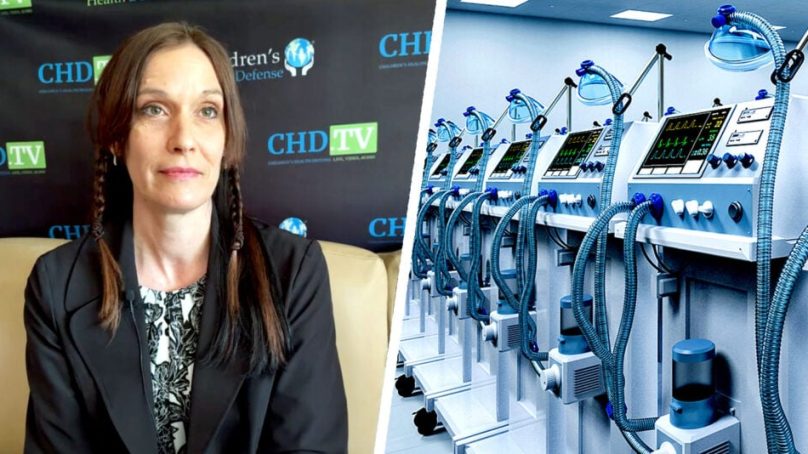
“Hospitals became the place where people go to die instead of the place where people go to get better,” said Zowe (not her real name), a medical coder who worked for several Phoenix, Arizona, hospitals during the Covid-19 pandemic.
In an emotional testimonial with Polly Tommey on Children’s Health Defense’s (CHD) “Vax-Unvax” bus earlier this month in Salem, Oregon, the whistleblower exposed the practices and protocols that she believes led to patient deaths.
As a medical coder, Zowe’s job was to review patient records and assign codes for diagnoses and treatments. The codes determined how hospitals and physicians were paid.
“I call it the central intelligence of the hospital or the SimCity level view,” she said.
But Zowe said what she witnessed during the pandemic left her distraught and compelled her to speak out. She says hospitals were not running out of beds when the pandemic first began and the “flatten the curve” initiative was announced.
“We didn’t have patients in the hospital at that time. They slowly started to trickle in maybe after months and months,” she said.
Despite the low patient numbers, hospitals were instructed to create bed capacity by sending patients home earlier than usual. Zowe noted that this practice was a significant change from pre-pandemic protocols, as it posed a financial liability for the hospitals.
“If patients came back, we would have to pay for their care,” she explained. “It’s a Medicare rule so that was definitely very different.”
New ICD-10 (International Classification of Diseases, Tenth Revision) codes for Covid-19 diagnosis and an updated code for Covid-19-related remdesivir treatments were introduced in 2020, leading to significant financial incentives for hospitals treating patients with the virus.
“They had to have that diagnosis in order to get the 20 per cent bonus for Covid patients,” Zowe said. She explained that a patient put on remdesivir also qualified the hospital for “an additional 20 per cent bonus in payment because of the risk of an unproven technology.”
Hospitals initially received free hydroxychloroquine from the national stockpile and people treated with it “were actually doing well” before hospitals suddenly switched to remdesivir, Zowe said.
However, after the Centres for Disease Control and Prevention announced the new ICD-10 code for Covid-19 infections, effective April 1, 2020, and the US Food and Drug Administration gave remdesivir an emergency use authorisation on May 1, things began to change.
“It was like a line in the sand,” Zowe told Polly. “We stopped azithromycin and hydroxychloroquine and we went straight to remdesivir.”
The financial incentives for using remdesivir led to its widespread use, despite the known risk, according to Zowe.
“The hospital had a protocol about remdesivir, they knew that it caused kidney damage,” Zowe said. She explained that the hospital required an infectious disease consult and a renal consult before administering the drug, and patients with chronic kidney disease stage 3 or higher were disqualified from receiving it.
However, many patients treated with remdesivir still developed kidney failure within a few days, she said.
“Some patients ended up going home with home dialysis prescriptions, some patients ended up on a kidney transplant list, some patients ended up with chronic kidney disease after they were given remdesivir – if they survived,” she said.
Zowe also addressed the misuse of ventilators. “At one point they [hospital intranet system] sent out a message that said the FiO2 [oxygen concentration] settings on the ventilators have been killing people,” she said. But when she went back to look for the message, it had been deleted.
Zowe says that after seeing the message, she monitored the number of patients dying on ventilators to verify that the settings had been changed – but discovered “the protocol was the same and patients were still dying on ventilators.”
The CARES Act provided funding for unlimited Covid-19 PCR tests, which led to a significant change in testing practices, according to Zowe.
“Normally testing costs hospitals money, so they don’t like to do a whole lot of diagnostic testing,” she said.
However, with the new funding and incentives, hospitals shifted from testing only symptomatic patients to testing all patients.
“Patients … would come in for a gallbladder removal or broken leg or a motorcycle accident or car accident or anything else,” Zowe said, “And while they were in the hospital, they would do the screen.”
“Eighty per cent of our patient population became Covid-positive whether they had symptoms or not – and that had never happened before,” Zowe said.
Zowe also revealed that patients were repeatedly tested until a positive result was obtained.
“They would do … six, seven, eight tests and it would be positive but the patient would have nothing wrong with them and the doctor would be really confused,” she said.
In other cases, patients would receive several negative tests followed by a single positive result, which would then be used to justify treating the patient for Covid-19.
Zowe said: “If they came up Covid-19 positive, that’s when they would start the treatment and they would put them on the ventilator fairly soon. They would start the remdesivir and then they would have kidney failure and pulmonary edema.
“They would just circle the drain and it was like nothing that the hospital could do would save them. … People died without being able to say goodbye to their families. Some of them just got a phone call. Some didn’t get anything.”
Zowe also witnessed a disturbing number of severe adverse reactions to the mRNA Covid-19 vaccines.
“I’ve never seen anything like that,” she said, describing patients with multi-organ failure who within hours would die of liver, lung, kidney … respiratory failure,” she said. “They called it ‘sepsis.’”
In addition to multi-organ failure, Zowe reported seeing patients with uncontrollable seizures. “Day patients would be seizing and no medications would stop it,” she said. “Eventually, they kind of had to be put down.”
“They called it encephalitis or encephalopathy and then later on even the coding information organization – AHIMA – admitted ‘Covid-19-associated encephalitis.’”
Other vaccine injuries included unusual blood clots, strokes and amputations.
Zowe described healthy people in their 20s accustomed to hiking and running marathons, who “suddenly needed a leg amputated because they had a massive blood clot going from their hip all the way down their leg.”
Despite these severe reactions, doctors often failed to connect the injuries to the vaccines. “They would just say, ‘It’s a stroke, it’s a heart attack, it’s a blood clot’ and they would never connect the two,” she said.
“Before they rolled out the mRNA injections, I didn’t know it was possible for a human to die so horrifically and so quickly.”
Medical coders faced significant challenges in accurately reporting Covid-19 vaccine injuries due to the lack of specific ICD-10 codes, according to Zowe.
“There was no way for us to actually report that anyone coming in with a heart attack or myocarditis or seizures or encephalitis or whatever it was … due to the Covid-19 vaccine,” she says.
She said the World Health Organization, which hosts the ICD-10 coding system, took years to make a specific code for Covid-19 vaccine injuries available.
“The best we could do was report it as due to ‘unspecified vaccine,’” Zowe said, noting that this code had been available for decades, alongside more specific vaccine injury codes for measles, mumps and rubella or MMR, tetanus, and flu vaccines.
Zowe said it’s important to have accurate ICD-10 codes for vaccine injuries because researchers and pharmacovigilance programmes use them to track adverse effects during clinical trials and post-marketing surveillance.
Researchers studying the connection between myocarditis and the Covid-19 vaccines would have to go through every chart with the “unspecified vaccine” code individually, Zowe explained, “and hope that the records are good enough to figure out, well, which vaccine was it?”
The experience of working in a hospital during the pandemic took an emotional toll on Zowe. “I knew they were killing people. … I would cry myself to sleep at night,” she confessed. “There was so much death. It was almost unbearable.”
Zowe decided to quit her job in April 2021 over the hospital’s vaccine mandates. “I would not be vaccinated and I would not be PCR tested,” she said. “I knew I wasn’t going to be able to get an exemption so I quit.”
Zowe’s distrust of hospitals and vaccines has left a lasting impact on her life. When Polly asked if she would take someone she loves to a hospital, Zowe replied, “That’s a really hard question because I want to say 100 per cent no, but there are some exceptions … [like when] your arm’s broken.”
She added, “I would have to know the doctor or the care team [at] that hospital. I would have to vet them.”
Zowe says she plans to publish a book on her experiences later this year.
- The Defender report / By John-Michael Dumais











